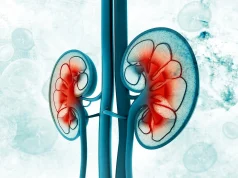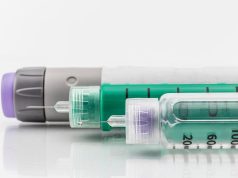Kidney Week 2015
The annual meeting of the American Society of Nephrology was held from Nov. 3 to 8 in San Diego and attracted approximately 13,000 participants from around the world, including nephrology specialists, researchers, scientists, and other health care professionals. The conference featured presentations focusing on the latest advances in the management of patients with kidney diseases and related disorders.
In one study, Farsad Afshinnia, M.D., of the University of Michigan in Ann Arbor, and colleagues found that deficient mineralization — defined as bone mass 2.5 or fewer standard deviations below peak bone mass of young healthy adults identified by densitometry — had a significantly higher rate at more advanced stages of chronic kidney disease (CKD), irrespective of the underlying bone pathology. In addition, the investigators also found that deficient mineralization predicted hip fracture; the rate of hip fracture had a graded increase by severity of CKD stage; and the adjusted mortality rate in advanced stages of CKD (stage 4 and 5) was significantly higher in patients with composite outcomes of hip fracture or deficient mineralization.
“These findings underscore the burden of deficient mineralization in CKD, and imply that bone densitometry may have clinical utility in risk stratification and identification of patients at high risk of hip fracture and therefore poor outcome,” Afshinnia said. “Appropriate application of densitometry in severe CKD and end-stage kidney disease can be used as an additional tool to identify a subgroup of patients at high risk of hip fracture. However, as densitometry is unable to differentiate osteoporosis with subtypes of renal osteodystrophy, upon identification of the high-risk patients, individualized clinical decision making for appropriate treatment is indicated. Further future research is required to optimize clinical care in high-risk CKD patients.”
Abstract No. SA-PO578
In another study, Nisha Bansal, M.D., of the University of Washington in Seattle, and colleagues found that acute kidney injury (AKI) is likely an independent risk factor for the development of subsequent heart failure among U.S. veterans.
“U.S. veterans who developed AKI during a hospitalization had a greater risk of subsequent development of incident heart failure within two years, accounting for a broad range of risk factors for AKI and heart failure,” Bansal said. “The findings of this study contribute further evidence that AKI is associated with long-term cardiovascular consequences. Further studies to identify underlying mechanisms and modifiable risk factors for AKI survivors at highest risk for incident heart failure are needed.”
Abstract No. FR-PO502
In a retrospective analysis, Jonathan Bazeley, M.D., of Indiana University in Indianapolis, and colleagues found that higher serum phosphorus levels in African-American CKD patients may be associated with faster progression to end-stage renal disease independent of estimated glomerular filtration rate.
“Future trials should evaluate whether reduction of serum phosphorus attenuates progression of CKD to end-stage renal disease,” Bazeley said. “This may apply specifically to phosphorus binding agents or more broadly to other agents/interventions which may impact mineral-bone disease in CKD.”
One author disclosed a financial relationship with Medtronic.
Abstract No. TH-PO560
ASN: ESRD Risk Can Be Estimated in Living Kidney Donors
MONDAY, Nov. 9, 2015 (HealthDay News) — The projected long-term risk of end-stage renal disease (ESRD) among living kidney donors can be estimated using multiple characteristics, according to a study published online Nov. 6 in the New England Journal of Medicine. The research was published to coincide with the American Society of Nephrology’s Kidney Week 2015, held from Nov. 3 to 8 in San Diego.
ASN: Telenephrology Improves Visit Compliance in CKD
MONDAY, Nov. 9, 2015 (HealthDay News) — For patients with chronic kidney disease (CKD), telenephrology may be superior to in-person care for visit compliance, and is not inferior to in-person care for management of CKD, according to a study presented at the American Society of Nephrology’s Kidney Week 2015, held from Nov. 3 to 8 in San Diego.
ASN: PPIs Linked to Higher Risk of Chronic Kidney Disease
TUESDAY, Oct. 27, 2015 (HealthDay News) — Proton pump inhibitors (PPIs) appear to be linked with increased risk of chronic kidney disease, two new studies suggest. Findings from the studies are scheduled to be presented next week at the American Society of Nephrology’s Kidney Week 2015, held from Nov. 3 to 8 in San Diego.
ASN: Insufficient Sleep Might Increase Risk of Kidney Disease
FRIDAY, Nov. 6, 2015 (HealthDay News) — Lack of sleep may be a gateway to chronic kidney disease, at least for women, a new study suggests. The results of the study are scheduled to be presented at the American Society of Nephrology’s Kidney Week 2015, held from Nov. 3 to 8 in San Diego.
ASN: Tenofovir-Linked Acute Kidney Injury Prevalent in HIV
FRIDAY, Nov. 6, 2015 (HealthDay News) — Acute kidney injury (AKI) associated with tenofovir disoproxil fumarate (TFD) is prevalent in HIV-infected patients, according to a study presented at the American Society of Nephrology’s Kidney Week 2015, held from Nov. 3 to 8 in San Diego.
ASN: suPAR Levels Prognostic for Chronic Kidney Disease
FRIDAY, Nov. 6, 2015 (HealthDay News) — Levels of the protein suPAR (soluble urokinase-type plasminogen activator receptor) can predict risk of developing chronic kidney disease up to five years before it begins causing damage, according to research published online Nov. 5 in the New England Journal of Medicine. The research was published to coincide with the American Society of Nephrology’s Kidney Week 2015, held from Nov. 3 to 8 in San Diego.
Copyright © 2015 HealthDay. All rights reserved.







